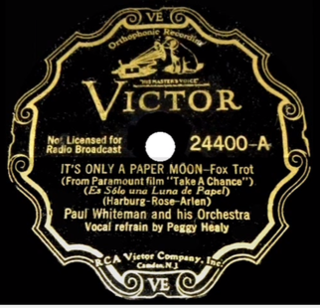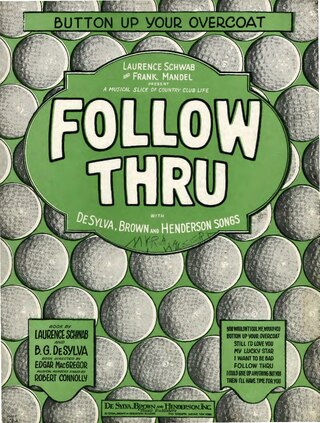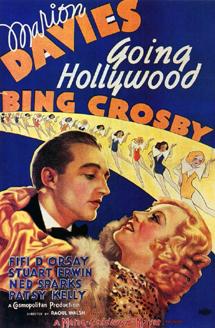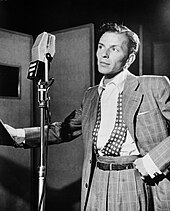
Harry Lillis "Bing" Crosby Jr. was an American singer, actor, television producer, television and radio personality, and businessman. The first multimedia star, he was one of the most popular and influential musical artists of the 20th century worldwide. Crosby was a leader in record sales, network radio ratings, and motion picture grosses from 1926 to 1977. He was one of the first global cultural icons. Crosby made over 70 feature films and recorded more than 1,600 songs.

Hubert Prior Vallée, known professionally as Rudy Vallée, was an American singer, saxophonist, bandleader, actor, and entertainer. He was the first male singer to rise from local radio broadcasts in New York City to national popularity as a "crooner".

Lemeul Eugene Lucas, better known by his stage name Gene Austin, was an American singer and songwriter, one of the early "crooners". His recording of "My Blue Heaven" sold over 5 million copies and was for a while the largest selling record of all time. His 1920s compositions "When My Sugar Walks Down the Street" and "The Lonesome Road" became pop and jazz standards.

Ruggiero Eugenio di Rodolfo Colombo, known as Russ Columbo, was an American baritone, songwriter, violinist, and actor. He is famous for romantic ballads such as his signature tune "You Call It Madness, But I Call It Love" and his own compositions "Prisoner of Love" and "Too Beautiful for Words".
"Prisoner of Love" is a 1931 popular song, with music by Russ Columbo and Clarence Gaskill and lyrics by Leo Robin.
"Without a Song" is a popular song composed by Vincent Youmans with lyrics later added by Billy Rose and Edward Eliscu, published in 1929. It was included in the musical play, Great Day. The play only ran for 36 performances but contained two songs which became famous, "Without a Song" and "Great Day".

"It's Only a Paper Moon" is a popular song published in 1933 with music by Harold Arlen and lyrics by Yip Harburg and Billy Rose.

"Button Up Your Overcoat" is a popular song. The music was written by Ray Henderson, the lyrics by B.G. DeSylva and Lew Brown. The song was published in 1928, and was first performed later that same year by vocalist Ruth Etting. However, the most famous rendition of this song was recorded early the following year by singer Helen Kane, who was at the peak of her popularity at the time. Kane's childlike voice and Bronx dialect eventually became the inspiration for the voice of cartoon character Betty Boop.

"Where the Blue of the Night (Meets the Gold of the Day)" was the theme Bing Crosby selected for his radio show. It was recorded in November 1931 with Bennie Krueger and his Orchestra. The song was featured in a Mack Sennett movie short starring Bing Crosby. Crosby recorded the song on several occasions starting with the November 23, 1931 version with Bennie Kruger and his Orchestra. He next recorded it on July 20, 1940 with The Paradise Island Trio. On July 17, 1945 he recorded it with John Scott Trotter and his Orchestra and his final recording was on April 21, 1954 with Buddy Cole and his Trio for his Musical Autobiography set.

Going Hollywood is a 1933 American pre-Code musical film directed by Raoul Walsh and starring Marion Davies and Bing Crosby. It was written by Donald Ogden Stewart and based on a story by Frances Marion. Going Hollywood was released by Metro-Goldwyn-Mayer on December 22, 1933.
"It's Been a Long, Long Time" is a big band-era song that was a hit at the end of World War II, with music by Jule Styne and lyrics by Sammy Cahn.

John Milton Owens was a singer-songwriter, pianist, and star of the longest running network radio show Don McNeil's Breakfast Club. He was known as "The Cruising Crooner" because of his unique showmanship of cruising through mostly female audiences attending the live Breakfast Club broadcasts, and crooning love ballads to the blushing and giggling women, often singing directly to them, one at a time, sitting on their laps, and nuzzling close to them.

Gus Arnheim was an American pianist and an early popular band leader. He is noted for writing several songs with his first hit being "I Cried for You" from 1923. He was most popular in the 1920s and 1930s. He also had a few small acting roles.

"Goodnight, Sweetheart" is a British popular song written in 1931. It has been performed by Al Bowlly, Kate Smith, Connie Francis, Dick Haymes, Gordon MacRae, Sarah Vaughan and Dean Martin, among others, and was the theme song for the 1990s BBC time-travel sitcom Goodnight Sweetheart starring Nicholas Lyndhurst, which was named after it.
For music from an individual year in the 1940s, go to 40 | 41 | 42 | 43 | 44 | 45 | 46 | 47 | 48 | 49

One for the Boys is a studio album recorded by American entertainer Connie Francis in 1959. It remained unreleased until 14 April 2023 when it was available for streaming on iTunes.
"Deep Night" is a song and jazz standard with a melody composed in 1929 by Charles E. Henderson and lyrics written by Rudy Vallee. The tune is written in a minor key.

Crosby, Columbo, and Vallee is a 1932 Warner Bros. Merrie Melodies cartoon short directed by Rudolf Ising. The short was released on March 19, 1932. It lampoons the popularity of crooners among young women, with popular crooners Bing Crosby, Russ Columbo, and Rudy Vallée being the namesake of the film.

Will Osborne was a Canadian-born American bandleader, trombonist, and crooner.

















